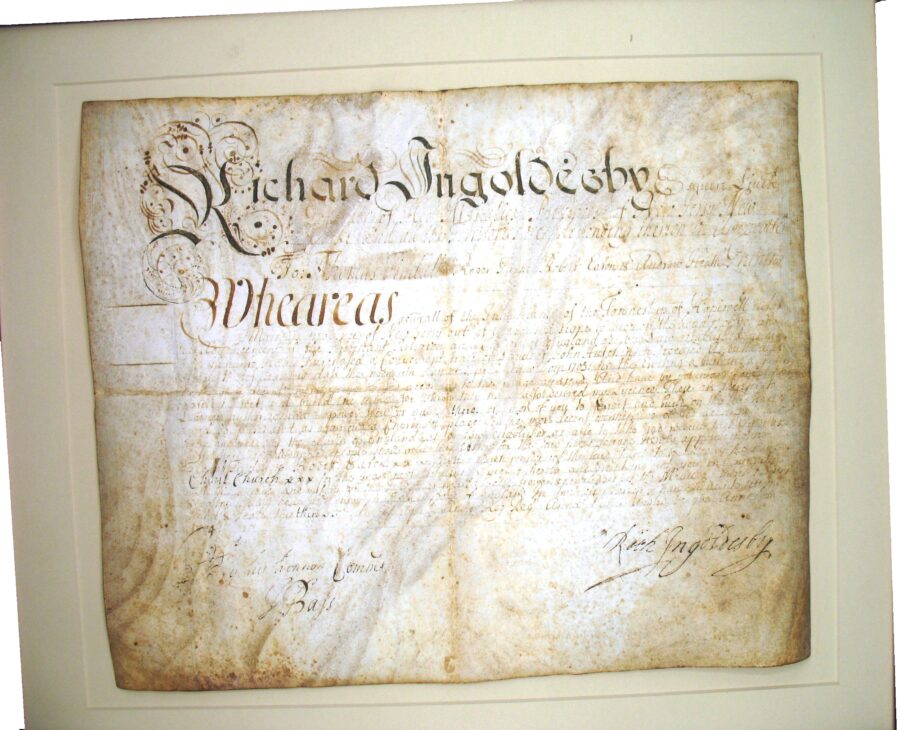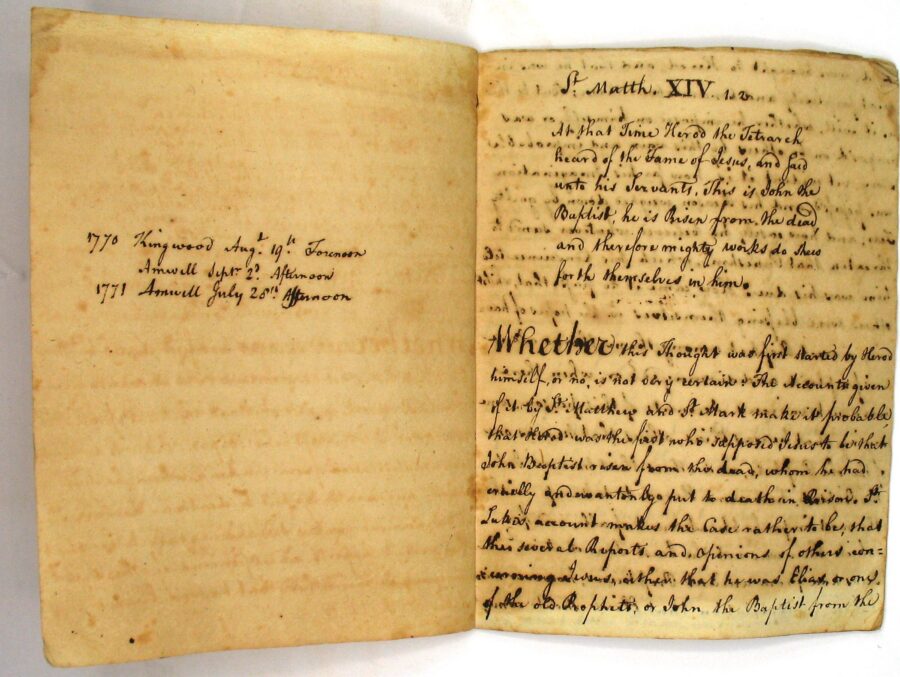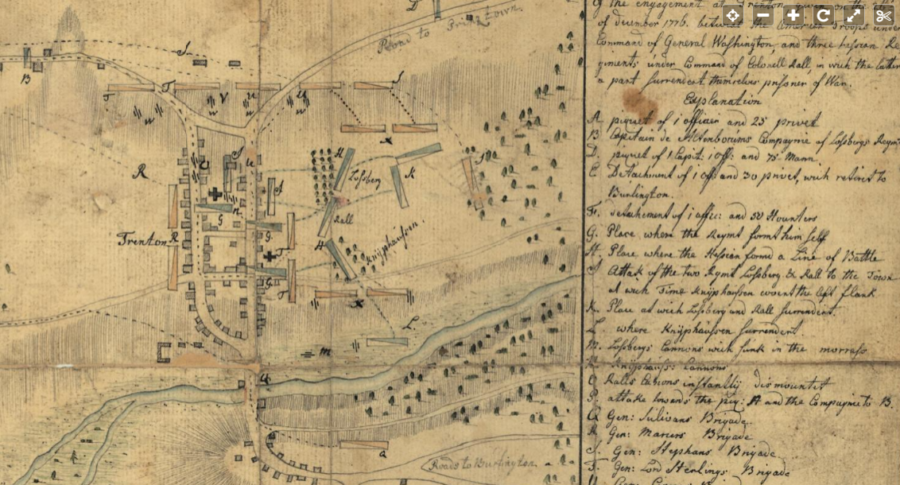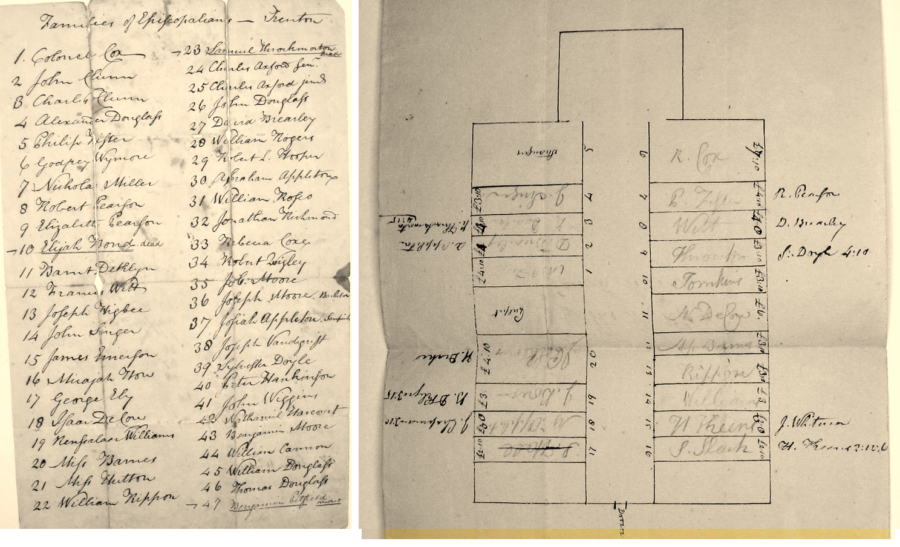Imagine Colonial New Jersey in 1703, the year acknowledged as the founding of St. Michael’s Church. There were sprawling farms, dirt roads, widely scattered manor and farmhouses, right here – at the narrowing of the Delaware River. The members of the Church of England who lived in the area called “The Township of Hopewell” (now Ewing), wanted to have a church of their homeland here. A tract of land owned by Thomas Hutchinson in the Township of Hopewell was given to them. They built a church in 1704-5 on the Breese Farm near what is now Trenton Psychiatric Hospital. The license to build the church was granted by Richard Ingoldsby, Lieutenant-Governor of the Province of New Jersey and New York. There is still a small plot that commemorates the church on the hospital grounds, and which we are currently working to have transferred to another arm of the State of NJ to be turned into an historic site open to the public .


The clergy for the early church were: Reverend John Talbot, a missionary; Reverend John Sharpe, Reverend Thoroughgood Moore, and several others. This church is referred to as the “Old Church” and was used until the building of St. Michael’s Church in Trenton. Queen Anne sent a silver communion service and communion linen to the Hopewell church in 1708 in acknowledgement. The service included a silver flagon in the shape of a goblet with an extended lip, which is now at the New Jersey State Museum.
A quote from David McCullough’s book, “1776,” describes Trenton before the Revolutionary War.
Trenton was often referred to as a pretty village… With perhaps a hundred houses, an Episcopal church [St Michael’s], a market place, and 2 or 3 mills, and iron furnaces… The principal streets were King Street and Queen Street, which ran parallel toward the river…
The Trenton church was located on King Street (now North Warren Street). The deed for the property was given by the Coxe family before 1748, and has been missing since 1755. It is known that the church was built before the autumn of 1748 because it is mentioned in a book written by Peter Kalm, while documenting his travels. Kalm, a Swedish explorer, botanist, and friend of Ben Franklin, came to Pennsylvania and subsequently established the Swedish settlement of Swedsboro, New Jersey. The King Street building of St. Michael’s was 40 feet square with a gabled roof (triangular sides with a sloping roof), and the pulpit was on the north side of the building. There is no documentation on the exact date the church was built. The way the name “St. Michael’s” was chosen is also a bit of a mystery; except the cornerstone was laid on the Feast of St. Michael, and the church name was mentioned in the vestry minutes of 1761.
Between 1750 and 1773 there were various rectors, and the church was without a permanent rector several times. From 1750 to 1758, the first full time rector was French, the Reverend Michael Houdin, a former Roman Catholic monk. During this time a lottery was held to raise funds to complete the church building.

The Revolutionary War spanned roughly 1775 to the early 1780’s, and during that time there were no church services at St. Michael’s. Because the congregation was made up of those loyal to the British Crown, as well as Revolutionaries who favored independence, the vestry passed a resolution on Sunday, July 7, 1776, to close the church indefinitely. The next day the Declaration of Independence was read on the steps of the Trenton Court House.
St. Michael’s saw many different faces of the Revolution. The Continental and British armies occupied the church. The Hessians, the German mercenaries who fought with the British army, used the church as a barracks and stable, and stored their artillery in the church yard while they occupied Trenton. When George Washington and the Continental army surprised the Hessians on December 26, 1776, some of the fighting of the Battle of Trenton happened in St. Michael’s church yard. There was hand to hand combat with swords, muskets, and bayonets on church grounds. Later in the war, the church was used by George Washington’s Continental Army as a hospital.

The church reopened on January 4, 1783 in serious disrepair, the result of the hard usage during the war. A committee was formed to determine what was needed to make the building habitable again. The church raised money for the repairs from pew rentals, and from money left to the church in wills. During the war, and prior to re-opening, David Brearley, the Chief Justice of New Jersey’s Supreme Court had married Elizabeth Higbee, daughter of one of the church’s key members, Joseph Higbee (No.13 in the list below). When the church re-opened, Brearley (no.27) was elected Senior Warden, and took an active part in the reestablishment of St.Michael’s. The church records (all of which are retained in our office and can be viewed either digitally or in-person) include the name of Samuel Adams, a free Black man, who in his will of 1792 left three pounds to the Episcopal Church.

In 1801, the Fifth General Convention of the Episcopal Church met at St. Michael’s. One of the most significant actions of this convention was the adoption the Thirty-Nine Articles of Religion. The Articles, originally forty one, were drawn up in 1553 in England, and with revisions along the way, are the basis of the fundamentals of the Protestant Episcopal Church as we know it today. Another historical event at St. Michael’s was the Diocesan Convention of August 1815, where The Rev. John Cross was elected the first Episcopal Bishop of New Jersey.
In 1843, the church added the Warren Street frontage. The Gothic Revival Style of the building façade resembles a castle. The principal sanctuary of St. Michael’s was renovated to resemble Lambeth Palace, the official London residence of the Archbishop of Canterbury in England. St. Michael’s had two turrets and a bell tower. The turrets and towers remain, but the bell tower is no longer standing. Standing across the street on Warren looking up at the front of the church, you will see the likeness of Lambeth Palace.
In 1844 a fence was built around the graveyard. The earliest tombstone is dated 1763. In 1823 Pauline Bonaparte, the infant child of Joseph Bonaparte, Napoleon Bonaparte’s brother, was buried in the church yard, a notable memorial. The next year, the family asked for more land for a family plot.
In 1858, some of the leading members of the church left to form a new parish – the nucleus of Trinity Church (now Trinity Cathedral) of Trenton.
The Parish House and the Chapel of St. Michael’s were built in 1892. Some of the church yard and cemetery were covered by the addition to the building. A number of headstones and plaques for the plots that were covered, were set into the walls of the new structure.
Many prominent colonials are closely identified with St. Michael’s Church. Among the vestrymen, wardens, and trustees have been Governors of New Jersey, Chancellors of the State, Justices of the State and of the nation’s Supreme Courts, State and United States Senators, Attorney General of the United States, and David Brearley, one of the framers of our Constitution.
In 1927 a valuable and detailed history of St. Michael's was undertaken by Hamilton Schuyler, historian at the Diocese of Trenton, and published by Princeton University Press in a limited edition. There are several copies in our church library. The entire text is incredibly available online here: ST. MICHAEL'S CHURCH HISTORY.
In 1960, St Michael’s personally invited the members of St Monica’s Church to become members here. It was an historical invitation because St. Monica’s was a Black Episcopal Church that began in a house on Spring Street here in Trenton in 1919. St. Monica’s eventually built their church in the 100 block of Spring Street but had to close their doors in 1960. The congregation was instructed by the Diocese to go to the Episcopal Church closest to them. St. Michael’s was the only church to offer a personal invitation. The Chapel here was dedicated and named for St. Monica’s Church in the 1980’s by Father Raul Mattei.
In 1997-98, the Parish House was renovated. The foundation needed repair, and during the excavation, the remains of the parishioners whose bodies had been covered by the expansion of the Parish House in 1892 were discovered – clothing still intact after more than 100 years. The remains were respectfully re-interred and a memorial service was held for them May 20th 1998.
Several of our parishioners are well versed in the historical detail of the church, and welcome you to engage them for more information. Mrs. Rose Richardson and Ms. Theresa Suanno provided some of the reference material for this brief account and Valerie Dromboski shared the very detailed book of called “History of St. Michael’s – 1700 to 1925” by S. Ella DeCou. A statement on the cover reads:
The story of the principal incidents from the beginning to the present date of St. Michael’s Protestant Episcopal Church, “The First Church of Trenton.”
Our memorial stained glass windows are outstanding. The colors and images are bright and clear and have an ethereal and calming quality, even on a cloudy day. We are proud and awed by our two historical Tiffany windows, and our St. Michael in full warrior regalia.
St. Michael’s is the oldest Episcopal Church in this area and one of the oldest in New Jersey. The church building is listed in the National Register of Historic Places.
Visit and take some time to look closely at our stained glass and the architectural details. Experience the colorful history of St. Michael’s Church and imagine yourself as part of history. You never know who was standing where you are: old George Washington, a soldier in the Continental Army, a Hessian soldier, one of the signers of the Declaration of Independence, William Trent, Napoleon’s brother Joseph, you never know…
